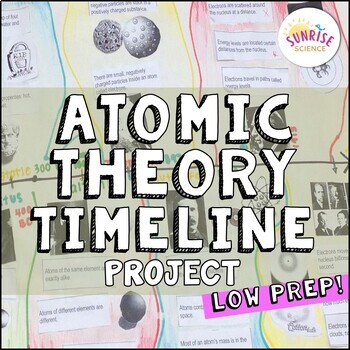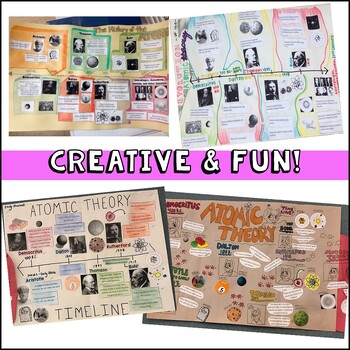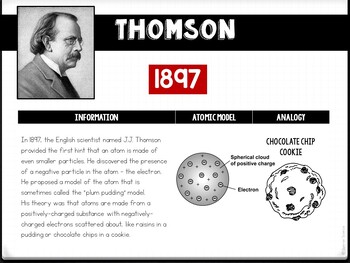Atomic Theory Timeline Project | History of the Atom | Bohr Rutherford Models
- PDF
What educators are saying
Also included in
- Looking for student-centered, engaging ways to teach your students about the amazing world of atoms, elements, and the periodic table? This is my favorite unit to teach because I love seeing students get involved in learning the genius of the periodic table and the relevancy of chemistry in our everPrice $43.00Original Price $57.57Save $14.57
- This is a bundle of all of my resources for teaching chemistry concepts at the 8th / 9th grade level, including laboratory equipment and safety, states, properties and changes in matter, atoms and the periodic table, and bonding and chemical reactions. These resources include a mix of Cornell DoodlePrice $195.00Original Price $252.47Save $57.47
- This is a bundle of all of my resources for teaching physical science at the middle school level! These resources include a mix of Cornell Doodle Notes, labs, demonstrations, inquiry activities, self-paced digital 5E lessons, manipulatives, projects, pixel art review activities, and assessments. IPrice $297.00Original Price $384.06Save $87.06
- This is a bundle of all of my resources for teaching physical science at the 8th grade level WITHOUT the Cornell Doodle Notes included. I put together this bundle upon request from customers who had already purchased my Growing Bundle of Physical Science Cornell Doodle Notes or my Entire Store BundPrice $187.00Original Price $246.28Save $59.28
Description
The Atomic Theory Timeline Project is everything you need to give your chemistry students a nice background on the history of the atom! Students use skills of synthesizing informational text, organizing pieces of information into groups and then into a chronological order, and displaying the information in a clear and creative way.
This project covers: Democritus, Aristotle and "the Death of Chemistry", Dalton, Thomson, Rutherford, Bohr, and the Modern Cloud Theory.
I like to show this Ted Ed video before we begin: http://ed.ted.com/lessons/the-2-400-year-search-for-the-atom-theresa-doud#watch
My students do this project in pairs. I provide them with 11" by 17" white construction paper for the "posters". They end up being the perfect size to fit all of the information/pictures, and they look great hung up in my classroom and are not too big!
Copy one "Information Book" (it looks fine in Black and White - I copy it back-to-back, put the pages into four plastic sleeves, and bulldog clamp the pages for use each year) and one set of the Directions and "Everything You Need to Make an Atomic Theory Timeline" per group or pair of partners. The Information Book is now also included as a digital Google document so you can share it with your students on Google Classroom and save paper!
The students read through the Information Book, cut out the "Everything You Need" pages and organize the images and information boxes into their own timeline. I encourage them to make the poster colorful in order to separate the information that belongs together. Some students get creative by decorating with ways to remember the models: "chocolate chip cookie dough" around Thomson's information or "Legos" around Democritus'.
There is a page containing 8 multiple choice questions and the project rubric. The students should answer the questions after completing their timeline, and tape the page to the back of their project to make grading easy for you! I think this project is a great way to make the students responsible for the learning, rather than making them sit through a boring PowerPoint!
If your students are not clear on the general concept of a scientific theory, please consider using my Differentiating Between Scientific Theories and Scientific Laws Group Activity as an introduction before beginning the Atomic Theory project!
You may also be interested in these resources:
The Atom Cornell Doodle Notes and Powerpoint
Modeling Atoms: Bohr Diagrams Cornell Doodle Notes
Atoms and the Periodic Table Digital or Print Task Cards
Thanks for looking!
Sunrise Science









